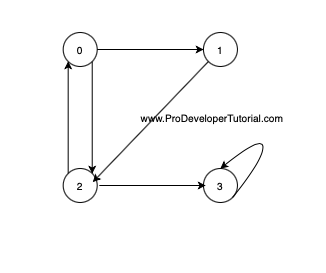Problem Statement:
You are given a directed graph.
You need to find out if the graph contains cycle or not.
Example

Solution
We shall use DFS to solve this problem:
1. We apply DFS for each vertex and keep track of visiting the vertices in recursion stack.
2. Then if we get a vertex that is already present in recursion stack then there is a cycle.
3. We use visited[] to keep track of already visited vertices.
4. recStack[] is used to keep track of visiting vertices during DFS. We will reset once cycle is not found.
Solution in C++
#include <algorithm>
//visit www.ProDeveloperTutorial.com for 450+ solved questions
#include <iostream>
#include <string>
#include <queue>
#include <vector>
#include <stack>
#include <list>
using namespace std;
class Graph
{
private:
int V;
list<int> *adj; // to hold adjacency list
bool helper(int v, bool visited[], bool *rs); // helper function for check_if_is_cyclic
public:
Graph(int V); // Constructor
void add_edge(int v, int w); // to add an edge to graph
bool check_if_is_cyclic(); // returns true if there is a cycle in this graph
};
Graph::Graph(int V)
{
// get the total number of nodes
this->V = V;
// initialize adjacency list for that number of nodes
adj = new list<int>[V];
}
void Graph::add_edge(int v, int w)
{
// add the edge to adjacency list
adj[v].push_back(w);
}
bool Graph::helper(int v, bool visited[], bool *recStack)
{
visited[v] = true;
recStack[v] = true;
list<int>::iterator i;
for(i = adj[v].begin(); i != adj[v].end(); i++)
{
int adjVertex = *i;
// check if the vertex is already visited, if it is not visited
// then call the helper function.
if ( !visited[adjVertex] && helper(adjVertex, visited, recStack) )
return true;
// if the vertex is visited, then check if is also there in recursion stack
// if it is there, then there is a cycle
else if (recStack[adjVertex])
return true;
}
recStack[v] = false; // remove the vertex from recursion stack
return false;
}
bool Graph::check_if_is_cyclic()
{
bool *visited = new bool[V];
bool *recStack = new bool[V];
for(int i = 0; i < V; i++)
{
visited[i] = false;
recStack[i] = false;
}
// call the helper function
for(int i = 0; i < V; i++){
if (helper(i, visited, recStack))
return true;
}
return false;
}
int main()
{
Graph g(4);
g.add_edge(0, 1);
g.add_edge(0, 2);
g.add_edge(1, 2);
g.add_edge(2, 0);
g.add_edge(2, 3);
g.add_edge(3, 3);
if(g.check_if_is_cyclic())
cout << "Graph has a cycle";
else
cout << "Graph doesn't have a cycle";
return 0;
}
/*
vector<vector<int> > result = combine(n, k);
cout<<"Result = "<<endl;
for (int i = 0; i < result.size(); i++)
{
for (int j = 0; j < result[i].size(); j++)
{
cout << result[i][j] << " ";
}
cout << endl;
}
*/
Output:
Graph has a cycle